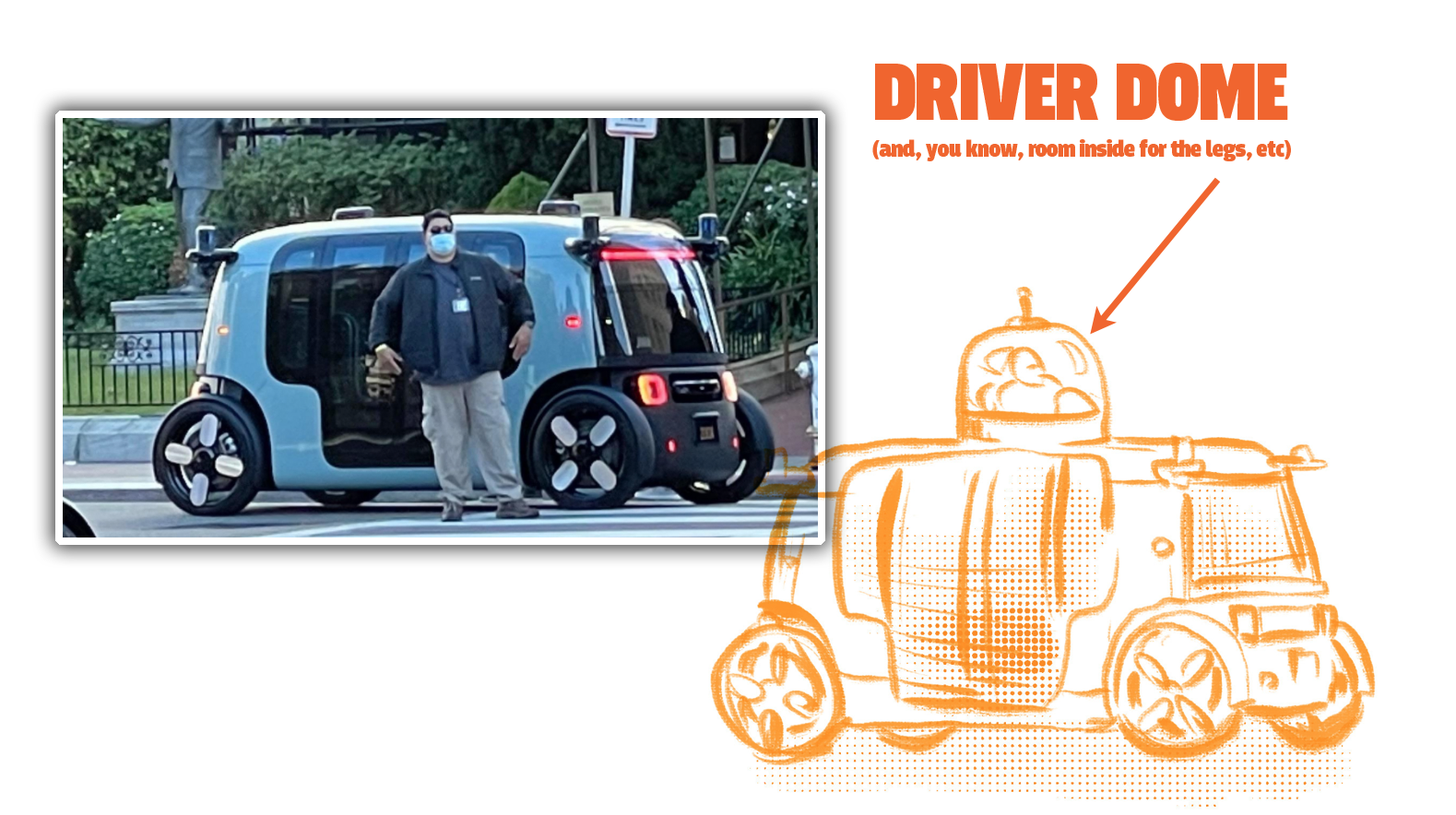I was thinking about Monday’s story where the autonomous robotaxi/small bus company Zoox was spotted shooting some sort of promo video with their new bi-directional autonomous transport cube-vehicle when it occurred to me that this company could be accomplishing all of their goals for likely a lot less money than the $US1.2 ($2) billion Amazon put into them with one little change: use human drivers. I know, I know, the whole point is that they’re developing autonomous vehicles, but, let’s just take a moment and ask why? Having an AV will be a life-changing thing if it’s on your private vehicle, but if you’re getting a ride on a shared one or robotaxi? Not so much, really.
Here’s a tweet from Zoox, explaining what they’re wanting to accomplish:
Our shared fleet of all-electric Zoox vehicles will reduce gas-powered cars on our streets. Less congestion, less pollution. Revealing 12.14.2020. pic.twitter.com/2c7lIeL7A1
— Zoox (@zoox) December 8, 2020
Now, just walk through this with me here. Let’s say Zoox developed essentially this same vehicle, with all its same basic features — electric, comfortable room-on-wheels-design, bidirectional — but instead of going through the incredibly costly and time-consuming effort of developing full Level 4/5 AV, they just hired drivers? Couldn’t they still accomplish what they stated in that tweet?
They could still be doing novel things, like positioning the driver in a swivelling pod up high to allow for bi-directional driving still, they’d still stand out from the crowd of other rideshare services, they could still be using advanced tech for route optimisation and all that, but they’d be doing it with the autonomous driving ability found in meat-computers that have proven driving experience.

From the perspective of their customer base, what’s the difference? Aside from those who just like the idea of robo-cars conceptually, there’s no difference at all. You summon your vehicle, you get in, you do whatever, you get out when you arrive. That’s it. From the perspective of the people actually using Zoox’ proposed service, it matters not one tiny wet bit what is actually piloting those vehicles.
Plus, this also means jobs for drivers, too. And if those drivers are well-trained and well-compensated, they could be really very safe — when AV geeks trot out statistics about how many crashes are caused by driver error, do they ever pare down the sample size to well-trained, well-paid, professional drivers?
I’m actually asking because I really don’t know — I’ve never seen or heard those particular statistics.
The reason companies like Zoox want AV, and why companies like Uber absolutely need it in order to make money at all, is that they don’t want to pay drivers.
So, instead of paying drivers, they’re dumping a metric fuckload of money into trying to develop tech to get rid of those jobs.
And, again, this does not benefit the customers — it only will help the companies make more money at some vague point in the future.
Now, privately-owned AVs are a different story, as having a self-driving private car is a completely different experience than owning a human-driven car. If you’re in the back of a cab or bus or train, it doesn’t really matter what’s controlling it, because in none of those situations is it you.
But for your own car, it makes all the difference, because when you don’t have to drive your own car, you can do whatever you want with the time you once spent driving, being productive, sleeping, having a refreshing wank, whatever. It’s a genuinely different experience than a human-driven car.
Now, most pundits and smart people seem to think that shared AVs are the way we need to move ahead because that’s the way traffic problems get solved. In fact, studies suggest a lot of personally-owned AVs could increase traffic because of return trips that are unoccupied, or, possibly, greater use of travel because it becomes just so damn easy.
So many people with more degrees than a protractor feel the path forward is via shared AVs. Here, read this:
Yet the underlying logic for autonomous driving, especially in cities, remains intact. We believe electric, shared AVs — also called robo-taxis or -shuttles — could address mobility’s pain points in cities (such as road congestion, crowded parking spaces, and pollution) while revolutionising urban mobility, making it more affordable, efficient, user friendly, environment friendly, and available to everyone. If integrated seamlessly in the public-transportation system, it will be an important enabler in reducing today’s share of private-car traffic (Exhibit 3).
Here’s what I don’t really get: Couldn’t all these shared AVs be human-driven vehicles, and the basic plans would still work?
Sure, you’d have to give people jobs and pay them, and that’s not cheap, but neither is developing AVs. Again, from the perspective of the riders, it just doesn’t really matter.
And, also, we know this works, because those are cabs and buses and all sorts of things we’ve been doing for literally centuries.
I’m pro autonomous vehicle development — I love robots and cars, and while I always intend to drive, at some point you have to look at all the time and effort being put into self-driving robotaxis and shuttles or whatever and just think, hey, they could be all ready to go tomorrow, not in ten years if all goes well if they just put a human in the driver’s seat.
But, this makes everything less fun, because then we’re just talking about new public transportation design, and that fails to engorge/moisten anyone’s genitals.
Now that the thought is in my head, I can’t shake it. Zoox could have started years ago with human drivers, and been developing AV tech simultaneously. They could even be considering remote-control vehicles. But, of course, as Uber has shown, it can be really, really hard to make money if you have to actually pay people, it seems.
All of these companies pouring money into AV development are, as you may have guessed, companies, and as such all they give a shit about is making money. So if there’s a way to run the business without paying employees, that’s what they want to do.
As miserable as Tesla’s approach to autonomy is, with all the obfuscation and public testing of beta software and gross timeframe miscalculations, they may have the right idea on one thing: autonomy will be best used on private vehicles, at least from the perspective of the owner.
If there’s a use case where autonomy really makes a beneficial difference on a shared vehicle that doesn’t have anything to do with not hiring someone or making money for a company, I have yet to really see that.
I won’t mind being proven wrong, but I also wouldn’t mind seeing more jobs for drivers in interestingly-designed electric rooms-on-wheels, either. Because I’m not a shareholder in any of these startups, so, you know, fuck ‘em. Make less money and hire some drivers!
